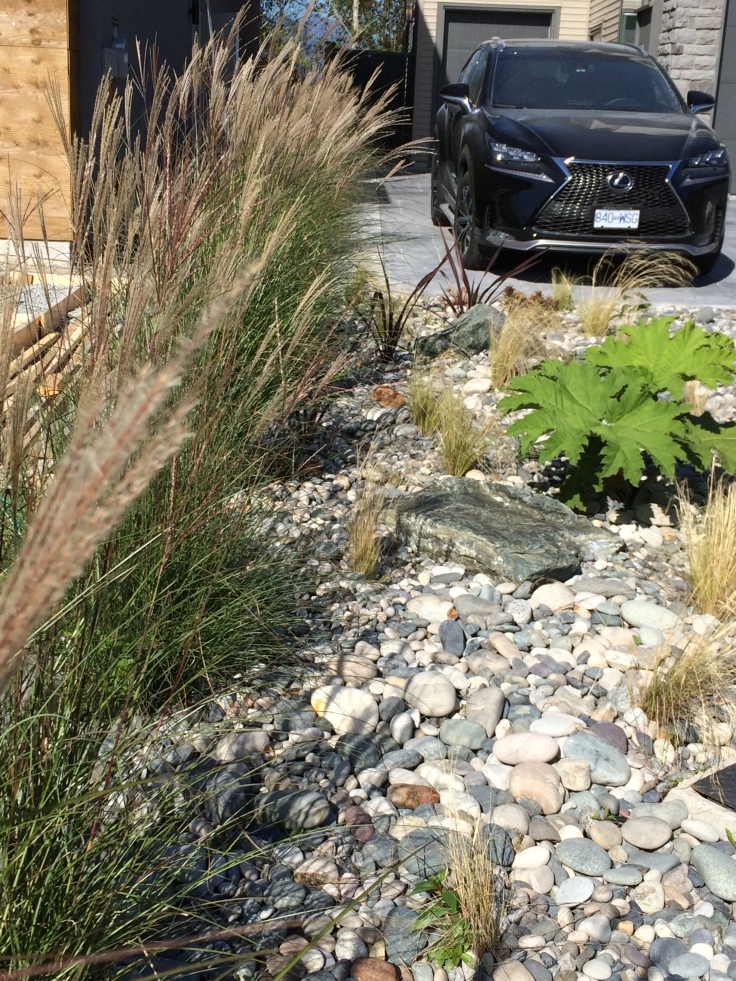How To–Ornamental Grasses
I wanted to post this several weeks ago, but then we had another dump of snow (haven’t heard the stats, but more snow this winter than I’ve experienced in my many years here on the Wet Coast!)
But it’s now seasonably warm, the ice all gone and most of the snow, so I got out yesterday and trimmed my ornamental grasses.

Northcoast Gardening has a great series on pruning ornamental grasses, and I checked it out before starting my own.
The other thing I checked before starting was whether I wanted to start at all yet. There are still seed heads on some of the grasses (admittedly not that many) and I love to leave them for the birds. And of course, one of the main reasons for not trimming down your grasses in the fall is the winter interest they provide while all your herbaceous plants (think Hostas and Daylilies) are completely dormant and underground. Not a problem when the ground is covered with snow, but we seldom have snow, so the alternative is an expanse of soil or (preferably) mulch.
Two observations made my decision: it’s warming up and things are starting to “bloom and grow”, and I don’t want to find myself cutting off bits of new growth while eliminating old growth. And the unusual volume of heavy wet snow over the past two months has done to my plants what the rest of the country experiences every year–made a mess. It’s making me re-think my “no Fall clean-up” philosophy…
Thus
I started with the Mexican Feather Grass (Stipa tenuissima, recently renamed by the botanists as Nasella tenuissima for who-knows-what-reason).

This jumble of grass is three MFGs on the right, a Frosted Curls centre and another to the left of the pic, all helping to hide the waterfall reservoir, which unfortunately you’ll see later on…

With a lot of grasses you can use a method of pruning not unlike combing hair. Using rough gloves–rubbery or leathery–just reach down to the base of the grass blades and comb. Most times you’d use this method if there’s still a lot of green present in the clump.

This system has worked best for me when I’m tidying up at other times in the year, especially getting rid of particularly messy seed heads (notwithstanding what I said before about leaving them for the birds. Sometimes they’re just too messy!) It didn’t work at all yesterday for the MFG. So instead I did the ponytail thing:




This particular plant has been in this spot for about three seasons, and clearly it’s time to lift and divide. Many plants really need to be divided every few years because the centre rots or otherwise dies out, and the rot/death can spread to the rest of the plant killing the whole thing. But when you see this happening, or if one year your grass just doesn’t grow very well, it’s the signal to lift and divide. When I do it in a few weeks time (could have done it yesterday but…didn’t) I’ll show you how.
Carex
On to the Carex:


This still has lots of green visible, so I’m not going to chop it down like the MFG, just comb it. The one at the top of this page is even greener, so I didn’t do anything with it. The others however are totally straw-y, so cut them right back into little porcupines. You can see that I left a little height on the “straw”, as much for convenience of cutting as anything else. It’ll be hidden by new growth.

Other grasses
This Japanese Forest Grass is really offering no particular beauty to the garden but I still decided to leave it as is:


The JFG is really slow to sprout, so rather than forgetting where it is and digging through it by accident, I decided to leave the detritus for now. I’ll check regularly for new growth and cut this right down to the ground as soon as there’s anything to see–which won’t be until well into Spring. Japanese Forest Grass (or Hakone Grass–Hakonechloa macra) behaves much the same.


The Miscanthus(es) above can be treated the same as the MFG. Note that these two varieties are dwarf and therefore pretty easily managed. Larger Miscanthus (aka Maiden Grass) require a slightly different method which you can read about in Northcoast Gardening.


The Panicums (Switchgrass) and Pennisetums (Fountain Grass) are also treated the same.
So what isn’t treated the same?

These two.
The Blue Fescue will probably only need a light “combing” to get rid of dead leaves, but every 2-4 years will want to be divided to maintain the shape we all know and love. And the Phormium should only have the tatty-looking blades removed right down to ground level. If they get to the point where most of the blades are in rough shape (what are they like now after all our heavy snow?), the whole plant can be cut back to ground level. Unfortunately, they’ll be slow to return to they’re former beauty…
Questions
If you have questions about your own grasses, feel free to post them here and I’ll get back you with either an answer or more questions.


Would love to hear your comments. Go to Client Site Analysis page for design help.